Outbreak of war
On 3 September 1939, Great Britain declared war on Germany. As in the First World War, Australia was not directly threatened by this conflict thousands of miles away. But as a loyal member of the British Empire, Australia again raised a volunteer force for overseas service wherever it was needed. During 1940 and 1941 the men of the Second Australian Imperial Force (the AIF) found themselves fighting the Germans and Italians in Egypt, Libya, Greece and Crete.
Japan strikes south
Right from the beginning of the war, Australia was concerned that Japan might also become involved. To strengthen the Empire’s defences in Asia, Australian soldiers were sent to Malaya in February 1941. These men became part of the forward defences of Britain’s greatest naval base in the region - Singapore. As long as the Royal Navy in Singapore guarded the sea between Australia and any enemy to the north, Australians felt safe.
On 8 December 1941, Japan declared that the day of European domination of Asia and its resources was over. Japanese troops landed on the north coast of Malaya, and in a daring move, Japanese carrier-based aircraft bombed the United States’ Pacific fleet at Pearl Harbor in Hawaii. Japan hoped temporarily to destroy U.S. naval power in the Pacific and enable Japan to concentrate on the conquest of a huge Asian/Pacific empire. This would stretch from the Indian/Burmese border, down through Malaya, across the Indonesian islands to New Guinea, out into the Pacific as far as the Gilbert Islands and north to the Kurile Islands off Japan itself.

Like to copy this image? Please click here first
AWM 106586 Pearl Harbour, 7 December 1941. The Japanese carrier fleet made a surprise attack on Pearl Harbour, 360 Japanese aircraft attacking United States ships and the Oahu airfields. Of the United States battleships in port, six were sunk and one run ashore; 120 aircraft were destroyed and 2,403 men were killed. The Japanese lost 27 aircraft. Shown, the torpedoed battleship USS West Virginia, which is sinking alongside the USS Tennessee.
The fall of Singapore
The Japanese Army aimed to crush the British Empire forces in Malaya and Singapore in 100 days. It took them just 70 days. On 10 December, Japanese planes sank two British battleships, the Prince of Wales and the Repulse, sent to repel their invasion. In January at Gemas and Bakri in Malaya, Australian troops successfully ambushed Japanese forces.

Like to copy this image? Please click here first
AWM P02018.055 East Coast of Malaya. December 1941. Crew members escaping by scrambling over the side into life boats from the doomed RN battleship HMS Prince of Wales after the Japanese air attack.
Despite their bravery this did little to slow down the rapid pace of the Japanese advance towards Singapore. By 31 January 1942, all Empire forces had withdrawn to Singapore Island itself.
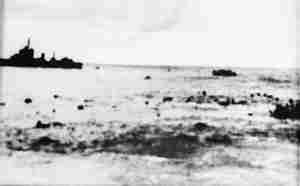
Like to copy this image? Please click here first
AWM P02018.058 East Coast of Malaya. 10 December 1941. Heads of crew members of HMS Prince of Wales and HMS Repulse bobbing in the water as a destroyer moves in for the rescue. Some 2320 men from both ships were saved after the sinking of the ships by Japanese bomber aircraft.
On 8 February, the Japanese landed in the north west of the island. Within six days they were on the outskirts of Singapore which was under constant attack. On 15 February, General Percival, the Commander, surrendered. At Singapore the Japanese took more than 140,000 prisoners, approximately 15,000 of them Australians.
The months of defeat
On 23 January 1942, the war crept closer to Australia - Rabaul in New Britain fell to the Japanese. On January 30, the Australian defenders of Ambon Island surrendered. On February 19, just four days after the fall of Singapore, the first ever air raid on the Australian mainland occurred. Darwin was bombed and 243 people were killed.
Further disasters followed. Timor was invaded on 19-20 February. Here Australian commandos conducted a guerilla campaign during the rest of 1942.
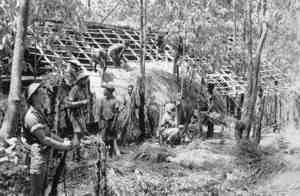
Like to copy this image? Please click here first
AWM 013763 Portuguese Timor 1942-11. Native Timorese constructing a bamboo hut for the use of Australian guerillas. The four Australians standing guard were members of the 2/2nd Independent Company which landed on the island early in 1942 as part of ‘Sparrow Force’.
Between 28 February and 1 March the Japanese landed on Java. Two ships, the USS Houston and the Australian cruiser, HMAS Perth, were sunk in the Sunda Strait attempting to prevent this landing.
On 3 March, an air raid on Broome in north west Australia cost 70 lives. On 8 March, Japanese soldiers came ashore on the mainland of New Guinea and captured Lae and Salamaua. On 12 March, all allied forces in Java surrendered.
By the end of March 1942, there was a line of Japanese-held territory directly to the north of Australia, stretching from Rabaul to Singapore. The Japanese had conquered their Asian/Pacific empire. Many Australians believed it was only a matter of time before Australia too was invaded.
The arrival of the Americans
Just after the defeat in Malaya, Australia’s Prime Minister, John Curtin, declared that “the fall of Singapore opens the Battle for Australia.” Curtin was aware that Great Britain, herself facing a huge challenge from Germany in Europe and North Africa, could do little to help Australia. Already at the end of 1941, Curtin indicated that Australia would have to seek a new ally to help defend its shores – the United States. On 22 December 1941, the first American soldiers arrived in Brisbane.
In February 1942, the American President, Franklin Roosevelt, decided to make Australia the main American base in the south-west Pacific. American and Australian forces would launch the fight back against Japan from Australia. Roosevelt ordered General Douglas MacArthur, the US commander in the Philippines, to proceed to Melbourne and there to take command of all allied forces in the area. Throughout 1942, Australia began providing camps, airfields and a whole range of other materials for the increasing number of American service personnel arriving in the country.
‘All in’
During 1942, Australians were told, not asked, that they must get 100 percent behind the war effort. Defence was the first priority.
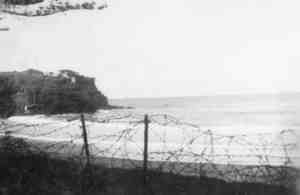
Like to copy this image? Please click here first
AWM 044546 Barbed wire emplacements on Manly Beach, Sydney, 1942.
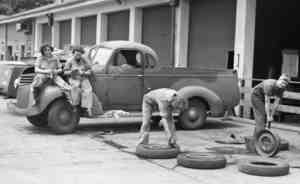
Like to copy this image? Please click here first
AWM 060917 Australian Women’s Army Service mechanics repairing tyres and carrying out maintenance work on Land Headquarters Signals motor vehicles at Albert Park, Melbourne.
Beaches were covered in barbed wire, older men were asked to join the Volunteer Defence Corps, air raid precautions were devised, a National Emergency Service prepared to cope with the possible results of an invasion and manpower laws directed people into essential war production. Hundreds of thousands of women found themselves doing jobs that previously had been done by men.
This freed men for the fighting services. But despite all their fears, the invasion never came!
Japanese plans
In early March 1942, the Japanese had debated what to do now that Japan had so easily gained her objectives. The Navy wanted to invade Australia and deny the country as a base to either America or Britain. The Army felt it did not have the strength to invade and fully occupy so vast a continent.
The Army won this argument. It was decided that from their new base at Rabaul, the Japanese would try to cut Australia off from America. This could be done by capturing various island groups in the Pacific – Fiji, the New Hebrides, Samoa and the Solomons. From these places, Japanese planes would make it impossible for American ships to get to Australia. In early May 1942, the Japanese struck.
The Battle of the Coral Sea
On 2 May, the Japanese landed at Tulagi in the Solomons. At the same time an invasion fleet headed towards Port Moresby on the south coast of Papua. This fleet was protected by planes from aircraft carriers. However an American carrier force supported by cruisers, and destroyers – HMAS Australia and HMAS Hobart among them – was waiting for the Japanese. American planes found the Japanese carrier Shoho and sank it. The Japanese also found an American carrier, the Lexington, and destroyed it. A Japanese carrier, the Shokaku, was also damaged as was the American carrier, Yorktown. However the Japanese, unsure of the full size of the American carrier force, retreated. Port Moresby had been saved.
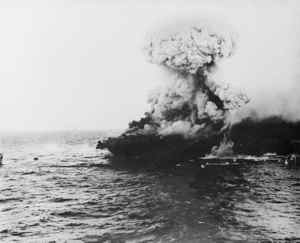
Like to copy this image? Please click here first
AWM P02018.098 Coral Sea, South West Pacific, May 1942. Smoke billows into the air from the burning carrier USS Lexington after attacks by Japanese torpedo aircraft.
Coral Sea was an important battle. It was the largest naval battle ever fought so close to Australia. It was fought entirely by aircraft attempting to sink ships. At no time did opposing ships fire at each other. Most important of all, it was the first time that the Japanese had been halted in their advance and turned back.
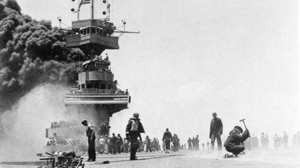
Like to copy this image? Please click here first
AWM P02018.117 Midway Island, Central Pacific, June 1942. A close view of the fire in the island (superstructure) of the carrier USS Yorktown following a Japanese air attack during the battle of Midway. The ship was later abandoned and sank.
Almost exactly one month later, near a small central pacific island called Midway, the Japanese Navy suffered a major defeat. Within a matter of hours the Americans sank four Japanese aircraft carriers. Plans for the capture of places like Fiji, Samoa and the New Hebrides were abandoned. From early June 1942, the Japanese no longer possessed the ability to cut Australia off from America.
The fighting in Papua, July-November 1942
Despite their defeat at Midway, the Japanese continued with their plan to cut Australia’s supply line with the United States. On 21-22 July they landed an invasion force on the north coast of Papua at Gona. From there they struck overland across the Owen Stanley Ranges towards Port Moresby. The only way over these rugged, jungle clad mountains was by a narrow path known as the Kokoda Track. In terrible conditions, young Australian and Japanese soldiers fought hard for control of this jungle pathway. By 17 September, the Australians had been driven back as far as Imita Ridge within sight of the lights of Port Moresby – the Japanese objective. However, confronted by strong defences and nearly starving, the Japanese decided to retreat. Pursued by the Australians, the Japanese by 15 November were back where they had landed on the north coast.
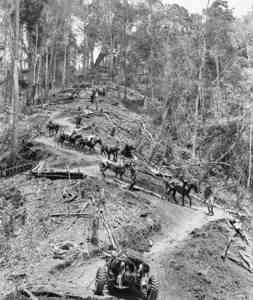
Like to copy this image? Please click here first
AWM 027025 Papua, October 1942. Men leading pack horses and mules loaded with supplies down the precipitous curving track from the end of the road down into Uberi Valley over which troops and supplies were taken to our forward positions in the Owen Stanley Ranges. In the foreground may be seen a 25-pounder gun that is being man-hauled through the valley to Imita Ridge.
Meanwhile, at Milne Bay, on the far southern coast of Papua, a Japanese force had been decisively beaten by Australians. The Japanese had landed here as part of a two-pronged attack on Port Moresby –one attack was to go overland from Gona and the other around the coast.

Like to copy this image? Please click here first
AWM 013320. October 1942. An Australian infantry section passing a Japanese type 95 HA-GO light tank knocked out at Milne Bay. These tanks had given the Australians a rough time in the early stages of the Japanese invasion.

Like to copy this image? Please click here first
AWM 013491 6 November 1942. An Australian anti-aircraft battery somewhere in New Guinea, manned entirely by Victorians using guns manufactured in a Victorian factory. Their bag of enemy planes to date - 43.
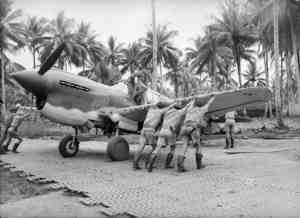
Like to copy this image? Please click here first
AWM 026648 Milne Bay, Papua, September 1942. The efforts of the two RAAF squadrons of Kittyhawks (75 and 76 Squadrons) in the fierce Milne Bay campaign helped drive the Japanese back into the sea.
Airstrips had been built at Milne Bay to allow Australian and American planes to attack out to sea towards the north and to defend eastern approaches to Port Moresby. As the Japanese tried to capture these airfields, Australian soldiers and planes of the RAAF beat them back. This was the first defeat of a Japanese force on land during the Pacific war.
Guadalcanal
The other main Japanese effort to control the Pacific sea lanes was made in the Solomon Islands. They built an airfield at Guadalcanal intending to extend their bombing range towards Fiji and Samoa. On 7 August, American marines landed on Guadalcanal and seized this airfield. The Australian cruiser Canberra was sunk in a night battle off Savo Island on August 9 as the Japanese navy tried to break through the allied defences and sink the American transport ships. Over the next six months the battle raged across Guadalcanal as the Japanese poured in thousands of men in an attempt to drive back the Americans. By March 1943, the Japanese abandoned all hope of retaking the island.
The Battles at Buna and Gona, December 1942 – January 1943
By early December 1942, the Japanese Papuan invasion force had retreated to strongly defended positions round Buna, Gona and Sanananda. Here they were attacked by a combined force of Australians and Americans. This was the first time that Australia had fought side by side with American land forces in the Pacific.
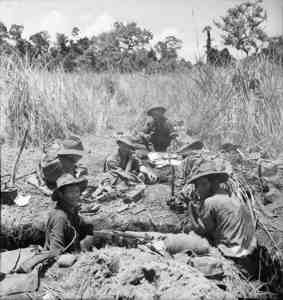
Like to copy this image? Please click here first
AWM 013761 Papua. Australian Troops in hastily constructed trenches on the Gona perimeter.
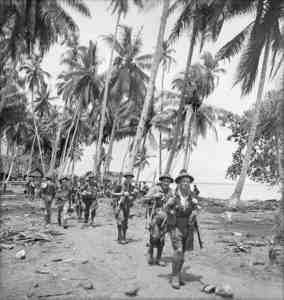
Like to copy this image? Please click here first
AWM 013821 Gona, Papua, December 1942. Australian troops move down the coast towards Buna.
The battles on the north coast were fought to the finish by the Japanese. Few allowed themselves to be taken prisoner. Many allied soldiers were killed, wounded or evacuated suffering from tropical illnesses. By 23 January, all the Japanese positions had been captured. The Papuan campaign was over. Throughout 1942, Australians had felt an invasion was possible. From January 1943, the Japanese were on the defensive throughout their island empire. Although the Pacific war still had two and a half years to run, the danger to Australia had passed.
The defence of Australia had been successful.





